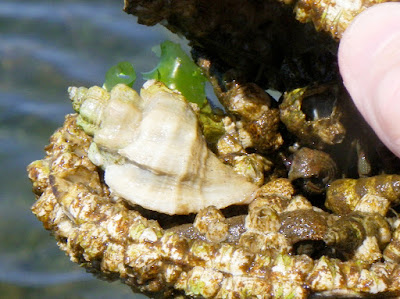 |
| A group removed from the clamshell |
 |
| A single capsule |
I was confused by these, but Brine Queen gave me the clues I needed. These are egg cases of an intertidal snail, and the tiny one seen near the exit at the top of one was probably a hatchling.
 |
| It's very tiny, but looks like a trophon, possibly Boreotrophon orpheus. At maturity, it would be about an inch long. This one is only a few millimetres. |
We narrowed the family of snails down to Muricidae, the rock snails, or murex snails. These are predatory snails, and include our common whelks, and the trophons, like the ones that ate their way through my aquarium a year or so ago.
Muricids lay eggs in protective corneous capsules the size and shape of which vary with the species. Out of these capsules the crawling juveniles, or more rarely planktonic larvae, hatch. (From Wikipedia)
 |
| There was an adult whelk in the clamshell. It wasn't the egg layer, though. |
Websites or books that include photos of egg capsules along with the adult snails are few and far between, but we found a few similar to the clamshell sample. None were quite a match.
We have often seen the egg cases of the common whelk, the dogwinkle.
 |
| Whelk eggs, found on the White Rock beach last spring. |
Several snails that occur locally have the curved, "winged" shape: the Oregon triton,
 |
| Image from WallaWalla.edu |
the Leafy hornmouth,
 |
| From Asnailsodyssey, with whelk eggs on the left. |
Pteropurpura trialata (this is from California; I don't know if it comes this far north),
 |
| From Wikipedia |
These are all similar, and obviously related, but they are more pointed than ours. And I have never seen any of these snails around here. So I'm tentatively sticking with the corded trophon, B. orpheus.
In this context, this afternoon we were back on the same beach, at low tide. We didn't go as far out as we had when I found the clamshell, but close. Among the trillions of mud snails, I found a different one, another Muricid:
 |
| A sculptured rocksnail, Ocinebrina interfossa, almost adult size. |
 |
| Bottom side, showing orange flesh. |
This is the first of these that I have seen. Another species to look for, and someday, to find eggs for.

Such amazing shots. You can see right through and see the snails developing inside. - Margy
ReplyDelete